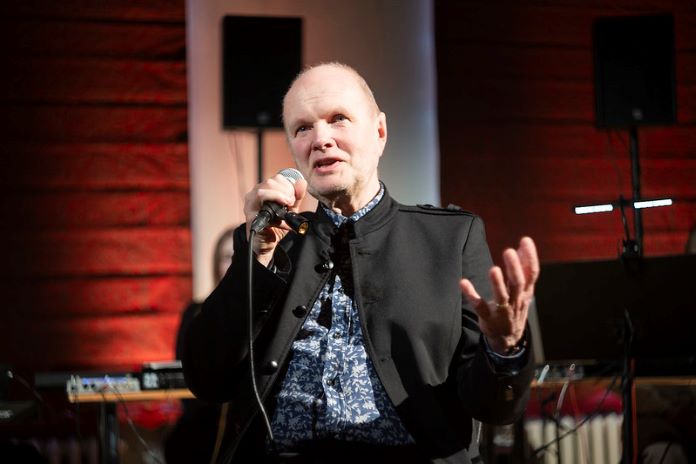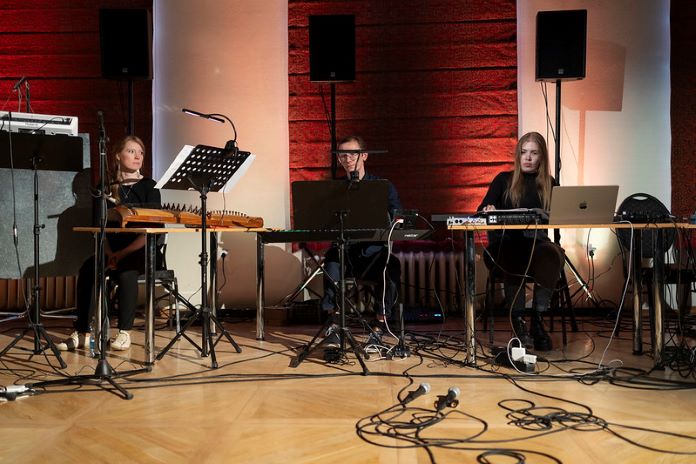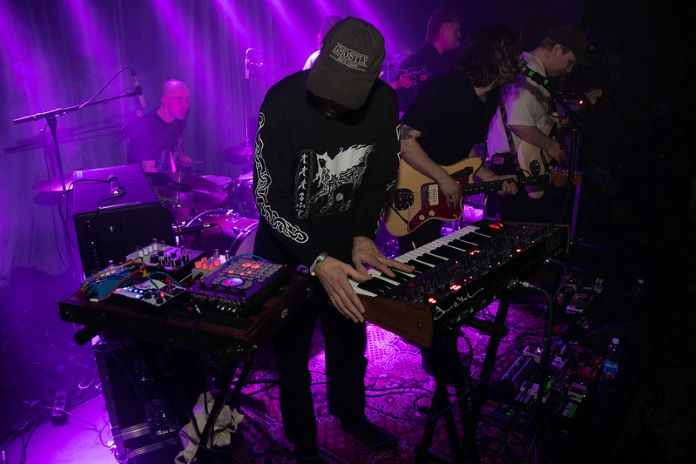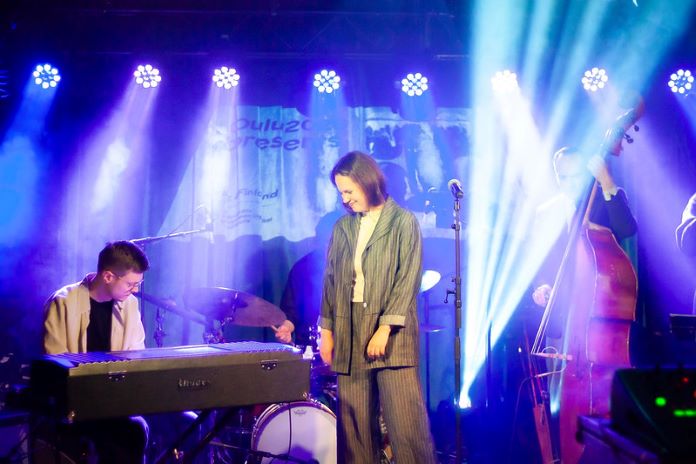
Sven Grünberg
Virta, Musta Huone, Mari Kalkun, Sven Grünberg
Tallinn Music Week, Tallinn, Estonia, April 3-7, 2024,
Apr 18, 2024
Photography by Saara Mildeberg (lead photo)
Web Exclusive
![]()
At the official opening of Tallinn Music Week, deputy mayor of Tallinn city Kaarel Oja reassures the audience: “When you don’t feel like it was one of the best weekends you have had over the last couple of months, then blame me”. Such words can rarely be heard from someone representing the world of politics in other countries. The 16th edition of Tallinn Music Week, one of the biggest showcase events in Northern Europe, continues the border-free trajectory enabling connection between what seems distant. Here, at the newly reopened Von Krahl Theatre, the president of Estonia Alar Karis is surrounded by members of the festival team, music industry professionals and culture vultures. During his welcoming speech, Karis sums up the all-embracing attitude of Tallinn Music Week: “Music and culture in general tell us that the only way of growing and developing is in the connection and relation with the other”.

Forty-five miles away from Von Krahl and Telliskivi, the formerly industrial and now gentrified creative district hosting the festival, Estonian nature and wildlife lift the lid on the unrestrained creative spirit and the idea of connection. While walking down a wooden path across Kakerdaja bog, a random visitor quickly grasps the country’s craving for self-expression. One-fifth of Estonia is bogs, and about 60% of its land is dense forests. The wetlands served as a shelter during the time of wars, and still are a place of refuge for numerous species of birds who nest here in safety and secure distance from humans. In fact, the name Kakerdaja is a reference to järvekaur or black-throated loon, a rare type of waterfowl whose clumsy walking conjures up one’s waddling in the bogs. The bird is also an integral element of the mythology invented in this part of Europe. Originally inhabiting these lands, Setu, an indigenous Finno-Ugric people, believed that the world was born out of an egg laid by järvekaur.
Naturally, this feeds into the folk music narrative. At the Fenno-Ugria showcase, Estonian kannel player and singer Mari Kalkun performs songs from her latest album Stories of Stonia, inspired by the connection between wild landscapes and myths plucked from the pure air of forests. Just as storytellers from the early days of Estonian history, Kalkun narrates tales of her land, the historical Võrumaa region. Loyal to her primary instrument (an equivalent of the zither), the musician invents a new language by augmenting her sound with keyboards. The stories are put in the contemporary context and seemingly reflect on the timeless prehistoric state of the world. “The world needs to be created again”, she tells her audience at F-Hoone, before embarking on a journey with a haunting chant-like “The Creation of Munamägi”.
.jpg)
At the same stage, AR-GOD restored the folk tradition of Udmurts, another Finno-Ugric ethnic group living further from their fellow Setu and Estonians, namely in the European part of Russia. Despite the distance, the language and tunes echo the repertoire of like-minded collectives in Estonia, including Mari Kalkun. Yet, the outfits and set-up hint at the specific time and place. The traditional dress of the singer Maria Korepanova is adorned with silver coins at the front hinting at the marital status of her protagonist.
If nature and mythology convey timelessness, Tallinn, the capital of Estonia, documents the story of the place simultaneously in a linear and circular fashion. One of the architectural highlights on Pikk street is a 16th-century Flandrian-style building known as Mustpeade Maja or House Of The Blackheads. It used to be a gathering place for the Brotherhood of Blackheads, mostly foreign merchants who stood by the city in the time of crisis. It is believed that in 1343-1345 Blackheads protected Tallinn, then Reval, from the attack of the indigenous Estonians who wanted to exterminate Danish and German landlords as well as to restore pagan traditions.
.jpg)
In this captivating setting, the legacy of the enlightenment protected by the Blackheads is reinstated by Sven Grünberg, a pioneer of Estonian electronic music. Pieces from his albums Hingus (originally released in 1981), Om and theme from the cult sci-fi film The Dead Mountaineer’s Hotel are performed here by EMA (The Ensemble of Estonian Electronic Music Society), consisting of six people. Initially recorded with various synthesisers, including massive EMS Synthi 100, and never performed live before 2021, the compositions now involve more than ten instruments that emanate the presets of the formidable invention. Alongside analogue keyboards is sheng, a Vietnamese instrument brought by Grünberg from Ho Chi Ming in the 1970s. “It’s one of my favourites among the Eastern music instruments. There are different possibilities, for example, this instrument can be very useful if you want to make vibrato. I used it on my Om record”.
Describing the environment when the record was originally conceived, Grünberg recalls the surreal vibe. “It’s a very strange story if you think about how big the Soviet Empire was at that time, and now it’s gone. As you can imagine, you are known in a country almost the same size as the USA, and you are quite known there, but suddenly this country disappears. For us, it’s gone, it’s a strange story, think about it”. Born out of temporary conditions, the music captures the permanence of a calm and absorbing mind.

Alongside local acts, a few showcases celebrate talents from countries as far as South Korea and Canada. In this kaleidoscopic world of cultures, Finland stands out. The tapestry of sound brought by bands from the neighbouring state eradicates stereotypes and genre-related labels such as heavy metal and rautalanka (instrumental rock). The diversity of the Finnish scene is celebrated at the Oulu 2026 showcase, named after the future European capital of culture (the status currently held by the Estonian city of Tartu). At Uus Laine, an atmospheric Tardis type of venue in the heart of Kalamaja district, seven bands can hardly fall into one category other than the country of origin. The programme starts with Selma Savolainen, jazz composer and her band, performing material from the latest album Horror Vacui. The experience is cinematic. Transparent to the degree of watercolour, the music evokes film scores to Polish new wave classics, e.g. Andrzej Trzaskowski’s theme from 1959’s Night Train. Unexpected vocal parts take the listener to uncharted territory suggested by the album title. A few hours later, the same stage is invaded by Musta Huone, noiseniks from Rovaniemi, currently based in Helsinki. They take the venue “hostage” with the avalanche of sound. The experience is similar to standing under a forceful water cascade.

At a showcase curated by underground festival Blow Up That Gramophone, Finnish experimental jazz trio Virta play compositions from their album Horros. The ebb-and-flow idiosyncratic music has an immersive effect. Antti Hevosmaa, Erik Fräki and Heikki Selamo pay attention to the texture and delivery, so each part – whether it’s flugelhorn, trumpet, guitar or customised percussion – sounds clear. Altogether though, they create an impressionistic image, with samples, vocals and whistles as contrasting brushstrokes.
Traversing across venues during Tallinn Music Week, one always finds such contrasts in harmony. Being in different worlds in terms of genres, bands channel their identities and exercise creative freedom through the medium of art. From the impeccable and vigorous show of Estonian punk-meets-NWOBHM collective Elukas to the playful and interactive performance of Tallinn-based art-pop artist Kitty Florentine, the city and its festival are never short of discoveries. There is certainly nothing to blame Mr Oja for.
Current Issue

Issue #72
Apr 19, 2024 Issue #72 - The ‘90s Issue with The Cardigans and Thurston Moore
Most Recent
- 10 Best Songs of the Week: Nilüfer Yanya, Linn Koch-Emmery, Fat Dog, Crumb, St. Vincent, and More (News) —
- Fat Dog Announce New Album and Tour, Share Video for New Song “Running” (News) —
- The Obsessed, Howling Giant @ Brooklyn Meadows, NYC, April 12, 2024 (Review) —
- Premiere: Slow Joy Releases New Single and Video for “King Cowboy” (News) —
- Premiere: Mackenzie Shrieve Shares New Single “Didn’t I Tell Ya” Feat. Jane Bruce (News) —

Comments
Submit your comment
There are no comments for this entry yet.